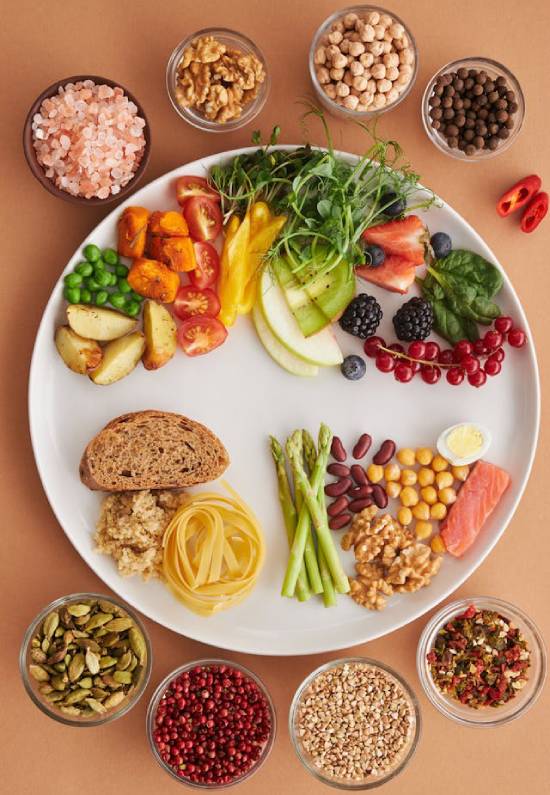Proper Nutrition for Health and Wellness
Good nutrition is the foundation of our health. It helps us feel better, gives us the energy to tackle life’s challenges, and allows us to enjoy the moments that matter most.
Adopting a balanced diet has become more essential than ever to combat the rise of lifestyle-related illnesses and improve physical, mental, and spiritual health.
So here are 5 key areas to help you achieve overall health and share this knowledge with your loved ones.
We’ll cover:
- What is proper nutrition and why it matters
- Key nutrients for nutrition
- Helpful and harmful dietary practices in African culture
- How to improve your dietary habits
- The link between nutrition and overall health
Let’s begin by looking more closely at why we need to be concerned with what we eat.
What is proper nutrition and why it matters

Photo by Vanessa Loring
Proper nutrition is choosing healthy foods and understanding the types and amounts of nutrients your body needs to thrive.
It ensures a balanced diet that includes the following:
- Macronutrients (protein, fats, and carbohydrates)
- Micronutrients (vitamins and minerals)
- Water
According to the World Health Organization (WHO), proper nutrition is a critical part of health and development which relates to:1
- Improved infant, child, and maternal health
- Stronger immune systems
- Lower risk of preventable non-communicable diseases (such as diabetes and cardiovascular disease), and longevity
- Improves learning
- More productive people
- Creating opportunities to break the cycles of poverty and hunger
There are many trending diets these days, like Paleo, Mediterranean, Keto, etc. However, research has shown that in general, a vegetarian diet (whole grains, legumes, nuts, vegetables, and fruits) is ideal for optimal wellness.2
For example, according to the National Institutes of Health (NIH),3 a healthy diet rich in fruits, vegetables, whole grains, plant proteins, and dairy products provides the essential nutrients for growth and development.
Another study conducted by Loma Linda University found that California residents who followed a balanced (and mostly vegetarian) diet of whole grains, nuts, fruits, and vegetables, had moderately lower rates of cancer, reduced risk of coronary heart disease, and lived six to nine years longer than the rest of the population.4
Similarly, the Nurses’ Health Study found that such a diet led to a 20% risk reduction of early death resulting from cancer, cardiovascular illness, and respiratory and neurodegenerative disease.5
From this, we can see that diet directly impacts the various aspects of our health including physical, mental, and spiritual as we’ll see next.
Diet and physical health
A well-balanced diet supports physical performance, recovery, and overall energy levels.
For example, imagine you skip breakfast. Later in the day, you will likely feel more sluggish. But, if you start your day with a balanced breakfast of whole grains, protein, and healthy fats, you’re more likely to feel sustained throughout the day without those energy dips.
By consuming a variety of whole foods, you can:6
- Boost your immune system, reducing the risk of infections and chronic illnesses
- Maintain a healthy weight by balancing portion sizes and nutrient intake
- Prevent diseases like diabetes, cardiovascular issues, and certain cancers through antioxidant-rich fruits, vegetables, and nuts
Proper nutrition promotes longevity, ensuring a vibrant and active life free from preventable ailments.
Just as nutrition impacts physical health, the benefits of a healthy diet also affect mental health as we shall see next.
Diet and mental health
What you eat also nourishes your mind.
For example, If you’ve ever had a “sugar crash” after indulging in sugary snacks or a fast-food meal, you know how it can often be more difficult to focus and think clearly afterward. Regular consumption of junk food can lead to chronic brain fog and a decline in cognitive performance.7
A 2021 study by the University of Lahore, Pakistan, found that students who ate healthy foods and followed regular three-meal-a-day patterns had better academic results, improved lifestyles, and higher self-confidence. In contrast, consuming unhealthy food more than seven times a week negatively impacted their school performance.
When we also consume a diet rich in omega-3 fatty acids, nuts, zinc, and plant-based proteins, we can enjoy benefits like:8
- Improved focus, memory, and cognitive performance
- Enhanced mood and reduced symptoms of stress, anxiety, and depression
- Increased clarity of thought and better decision-making

Photo by Milad Fakurian on Unsplash
What we eat also significantly impacts our mood, stress levels, and emotional well-being. Certain nutrients in food, such as vitamins, minerals, and healthy fats, support brain function and the regulation of mood-related chemicals like serotonin and dopamine.9
For example, when you’re stressed at work and reach for a sugary snack, it may give you a quick energy boost, but soon after, you experience a “crash,” feeling sluggish, irritable, or anxious. This happens because high-sugar foods cause blood sugar levels to spike and then drop, leading to mood swings and irritability.
Research done by NIH in 2023 found that healthy nutritional habits can even help reduce depression or anxiety!10
Both mental and spiritual health are intangible (unlike physical health) but both play a crucial role in our overall wellbeing.
Diet and spiritual health
Many spiritual traditions emphasize the importance of mindful eating, focusing on nourishment that sustains the body and honors the soul. Such practices, such as fasting or eating in moderation, are often linked to spiritual growth and self-discipline.
A good diet impacts our overall health, which is linked to our spirituality, as the Bible says:
“Beloved, I pray that you may prosper in all things and be in health, just as your soul prospers” (3 John 1:2, NKJV).
In addition, a prominent inspired health writer emphasizes that a clear and focused mind helps us better grasp the meaning of truth and the importance of eternal matters. Engaging in harmful habits, like poor eating choices, can cloud our understanding of spiritual matters that require higher levels of thinking and processing.11
For example, foods like alcohol can impair judgment and reasoning,12 making it harder to engage in spiritual practices. In contrast, a diet that nourishes the body and clears the mind enhances spiritual perception and awareness.
This highlights the important connection between nutrition and physical, mental, and spiritual well-being. Now, let’s delve into the key nutrients supporting all the above.
Key nutrients for wholesome health
A balanced diet is made up of various food groups that are classified into macronutrients or micronutrients.13
Let us look at each of them.
Macronutrients
These are foods that we consume in large quantities and are classified into 3 categories: carbohydrates, proteins, and fats.
Carbohydrates
Carbohydrates (carbs) are the body’s main energy source, fueling muscles and the central nervous system. They also provide dietary fiber, which aids in regulating blood sugar and promoting digestive health.14
Sources of carbohydrates include:
- Whole grain cereals such as brown rice, millet, maize, whole wheat, etc.
- Legumes such as lentils, cowpeas, peas, beans, and chickpeas.
- Vegetables such as kale, edible black nightshade, spider plant, pumpkin leaves, cabbage, etc.
- Fruits such as mango, watermelon, avocado, bananas, oranges, etc.
- Tubers like potatoes, sweet potatoes, yam, arrowroot, etc.
The Dietary Guidelines for America recommend we get 45 to 65 percent of our daily calories from carbohydrates.15
Carbs are a vital energy source, but to meet all our nutritional needs, it’s also essential to incorporate proteins into our diet.
Proteins

Photo by Vanessa Loring
These are foods essential for growth, tissue repair after injury, and maintaining a healthy body weight.16
They also boost immunity by making antibodies, are the building blocks of hormones and enzymes, and like carbs provide energy.17
Sources of protein include:
- Plant-based sources such as:
- Legumes like beans, lentils, and peas, etc.
- Plant-based milk such as soy, almond, cashew nut, hazelnut, etc.
- Nuts like macadamia, peanuts, almonds, cashews, etc.
- Seeds like sunflower, pumpkin, flax, chia, etc.
- Animal-based sources like fish, chicken, dairy, meat, and eggs.
It’s recommended that we get 10 to 35 percent of calories from proteins.18
Proteins are essential for our body’s growth and repair, but fats also play a crucial role in supporting. Let’s look at the sources of healthy fats and their importance in our diet.
Fats
Fats make cholesterol,19 which builds cell membranes and hormones like estrogen and testosterone, and cushion vital organs like the brain, heart, and kidney.20
All foods contain fat, which is classified into 3 groups:
- Unsaturated fats – These include
- Plant sources such as olive oil, canola, vegetable oils, nuts (almonds, cashews, walnuts, peanuts), seeds (chia, flax, pumpkin, sunflower), avocados, etc.
- Oily fish such as sardines and salmon are a good source of omega-3 fatty acids, which reduces inflammation and lowers the risk of heart disease according to the American Heart Association.21
Unsaturated fats are liquid at room temperature. These are healthy fats we want to include in our diets. They add flavor to meals and are also promote healthy skin.22
They also contain good cholesterol (HDL), which removes the bad cholesterol (LDL) that clogs blood vessels and causes high blood pressure.23
- Saturated fats – These fats are mostly from animal sources like ghee and butter, but coconut oil is also a saturated fat. They are solid at room temperature. It’s a good idea to avoid them, as they increase your risk of heart disease over time.24
- Trans fats – These are processed fats that are “partially hydrogenated,” like margarine or shortening. They are commonly used in processed foods like fries, crisps, cakes, doughnuts, and pies. These kinds of fats should be avoided since they contribute to increased risk for cancer and heart disease.25
So, while it’s recommended that we get 20 to 35 percent of calories from fat,26 it matters what type of fat we consume.
And apart from macronutrients like carbohydrates, proteins, and fats, our bodies also need micronutrients, in different quantities as part of a healthy diet.
Micronutrients
Micronutrients are needed in small amounts in our bodies. But just because only small amounts are needed doesn’t mean they aren’t as important. They are vital to healthy development, growth, disease prevention, and regulation of body functions.27 When we lack these nutrients, our health can suffer significantly.
They are categorized into minerals and vitamins.
Minerals

Photo by Ian Talmacs on Unsplash
These are inorganic substances that regulate various body functions. Examples of minerals include potassium, calcium, zinc, etc.
They are found in all food groups. However, some foods have a high concentration of specific minerals. For example, bananas are rich in potassium, while dairy products have high levels of calcium. So, it’s good to have a balanced supply of all different foods.
Minerals are classified into macrominerals and trace minerals.
Macrominerals
The bulk of minerals come from macrominerals.
Here are some examples of macrominerals, their functions, and sources:28
- Calcium: Supports bones, teeth, blood clotting, and heart function. It’s found in dark leafy greens, sesame seeds, dates, figs, fruits, etc.
- Phosphorus: Aids bone health and metabolizes proteins, fats, and carbs. Sources include seeds, nuts, etc.
- Potassium: Helps with healing and heart rhythm. Found in bananas, avocados, melons, fresh fruits, vegetables, etc.
- Magnesium: Supports bones, teeth, nerves, and muscles. Sources include green leafy vegetables, fruits, nuts, berries, etc.
Trace minerals
These are needed in smaller amounts than macrominerals. Here are some examples, along with their functions and sources:29
- Iron: Essential for healthy blood and clotting. Sources include sesame seeds, leafy greens, etc.
- Iodine: Supports metabolism, primarily in the thyroid. Found in sea salt, sea vegetables, and fruits like bananas, melons, etc.
- Zinc: Important for brain development and reproductive health. Good sources are pumpkin seeds, sunflower seeds, nuts, etc.
In addition to minerals, vitamins are another crucial component of our diet, playing key roles in supporting immune function, energy production, and overall health.
Vitamins

Photo by Wendy Wei
Vitamins are organic substances needed in small amounts for normal growth and development. They are mainly found in fruits and vegetables.
Vitamins are classified into fat-soluble and water-soluble types.
Fat-soluble vitamins
These consist of four vitamins: A, D, E, and K. They can only be absorbed into the body when mixed with a fat or oil medium.
Their function and sources include:30
- Vitamin A: Supports vision and immunity. It’s found in dark leafy veggies, carrots, oranges, etc.
- Vitamin D: Vital for bone health and blood clotting. Its main source is sunlight, but it’s also present in oily fish, fortified foods, eggs, etc.
- Vitamin E: Acts as an antioxidant and boosts immunity. Sources include olive oil, canola oil, nuts, etc.
- Vitamin K: Helps with blood clotting. Found in kale, cabbage, cauliflower, etc.
Water-soluble vitamins
They are absorbed into the body by water. They include vitamins C and B-Complex.
Their functions and sources include:31
- Vitamin C: Boosts immunity and repairs tissue. It’s found in citrus fruits, tomatoes, bell peppers, etc.
- B-Complex vitamins (B1, B2, B3, B5, B6, B9, B12): Support energy, brain function, and pregnancy. Sources include leafy greens, sprouted grains, nuts, etc.
The U.S. Department of Agriculture (USDA) recommends filling half your plate with fresh fruits and vegetables to ensure an adequate supply of vitamins.32
You might be wondering how these nutrition principles align with the African diet and how you can make improvements for a nutritious diet. Let’s look at that next.
Dietary practices in African culture

Photo by ZEUS THE CREATOR
Africans generally stay healthy by eating locally grown foods, but many have faced high mortality rates and nutritional deficiencies due to limited access to proper nutrition and food shortages.33 The rise of processed foods in the 21st century has also contributed to increased lifestyle diseases and mortality rates.34
These practices can be either positive, harmful, or based in myth. Let’s explore each one of them.
Positive practices
Africans get most of their nutrition from cultivated unprocessed crops such as whole grains, fruits, nuts, legumes, vegetables, and tubers.
Some of the beneficial traditional diets include:
- Fermented foods like porridge and injera are rich in probiotics,35 which aid digestion and contain essential minerals like calcium and iron36
- Whole grains like wheat, oats, barley, sorghum, millet, or quinoa
- Vegetables like amaranth, spider plant, edible black nightshade, kale, spinach, etc. are packed with vitamins and minerals.
- Boiled food like maize, beans, yams, etc.
- Tropical fruits like bananas, mangos, pawpaws, etc., are readily available in most parts of Africa.
- Tubers like cassava, yams, arrow roots, and potatoes are plentiful in most African countries.
Now let’s look at nutritional practices that are actually harmful to our well-being.
Harmful practices in nutrition
Let’s discuss things that can hinder proper nutritional intake. Dietary patterns continue to lean toward higher consumption of added sugars, unhealthy fats, salt, and refined carbohydrates in various low- and middle-income countries, including sub-Saharan Africa.37
These practices that can be detrimental to our health include skipping meals, consuming processed foods, overeating, or not getting enough of the right things to eat—malnutrition.
Processed and fried foods
These are foods with chemical additives and made with saturated fats or trans fats. They are the go-to foods for a fast-paced generation, especially in urban areas.
They include fries, crisps, and processed flour (white bread, cakes, cookies, doughnuts, etc.) Other foods such as soft drinks38 like sodas and cola, as well as alcohol,39 are packed with empty calories and are one of the causes of obesity, type 2 diabetes, depression, cardiovascular disease, etc.
It’s best to avoid alcohol entirely and cut down on fast food as they are a public health concern contributing to increased lifestyle and chronic diseases.
Overeating and malnutrition
We all know that eating the right balance of nutrients is key to good health, and as you can imagine, overeating or malnutrition can significantly throw off that balance.
Overeating is consuming too much food or focusing too heavily on one type of food, leaving other important nutrients out.
On the other hand, malnutrition is not getting enough food and of the right kind, leading to nutrient deficiencies.
This is a big concern for public health because both overeating and malnutrition40 can result in problems like stunted growth, osteoporosis, and even serious conditions like cancer, heart disease, obesity, type 2 diabetes, high blood pressure, etc.
By focusing more on the positive and cutting or limiting harmful practices, we lay the foundation for good health.
But what about those food myths (e.g., “African food is limited and unhealthy”) we all hear about? Let’s dive into some of them and see what’s true.
Dietary myths
There are plenty of misconceptions out there about what we should and shouldn’t eat, and sometimes these myths can lead us astray. Here are some of the most common ones in Africa:
- Carbs may lead to weight gain: Whole, or unprocessed, carbs are highly beneficial, but processed carbs are harmful. Whole carbs help in weight loss by making you feel full.41
- African food is limited and unhealthy: This is untrue as African food is loaded with healthy and nutritious options such as vegetables, tubers, whole grains, etc.
- If you don’t eat, meat you won’t grow: Many believe eating meat is a sign of good health, but this is not always true as many healthy people don’t use meat, and many who do eat meat aren’t optimally healthy.
- Fats, in general, are unhealthy: The fact is that trans fats and saturated fats are bad—but certain unsaturated fats, like olive oil, avocado oil, flaxseed oil, etc. are healthier and contain essential nutrients and fatty acids that promote adequate body function.
- If you don’t eat at night, you won’t sleep: This is more psychological (what we are used to). The night is meant for sleep and not much activity happens at night, so the food eaten before sleep is more likely to be stored as fat.42
The key takeaway is that balanced, well-informed eating is foundational to a healthy lifestyle. This leads us to how to improve our dietary habits and make healthier choices in our daily lives.
How to improve dietary habits
In our busy lives, prioritizing a nutritious diet is essential. These can be done through meal planning, the use of healthy swaps, using portion control tools, and affordable nutrition.
We’ll begin by looking at meal planning.
Meal planning: A blueprint for healthy eating

Photo by Spencer Stone
In today’s fast-paced world, planning your meals is more important than ever.
By taking time to organize what and when you eat, you can save time, reduce stress, and ensure balanced, wholesome meals every day. Here’s how to get started:
- Create a weekly menu: This helps you avoid the stress of last-minute food choices and ensures a variety of foods in your diet. A dietitian and online sources like MyplatePlan43 method can assist in creating a plan tailored to your needs.
- Batch cooking: Prepare meals in bulk and store them in the refrigerator for busy days. Foods like legumes and cereals are excellent for this option. And if you don’t have a fridge, you can always salt your meals and reheat them often for preservation.
- Utilize dried ingredients: Things like spices or dried fruits and vegetables can come in handy if fresh ones aren’t available, or if they’re out of season.
- Incorporate seasonal foods: Focus on fruits and vegetables that are in season, which not only makes them easier to find, but also typically more affordable, fresh, and nutritious.
With these meal-planning strategies, you’re on your way to better eating habits. But including healthy substitutions can also make a huge difference in your nutrition. Let’s see how.
Healthy substitutions: Small changes, big impact
Making healthy swaps in your diet can improve your nutritional intake without sacrificing flavor.
Here are some simple, effective substitutions to get you started:
- Whole grains for refined grains: Replace white rice, bread, and pasta with brown rice, whole-grain bread, or quinoa.
- Unsaturated fats for saturated fats: Opt for nut butter, olive oil, or avocado oil instead of butter or margarine.
- Variety of fruit for sugary snacks: Satisfy your sweet tooth with fruits like apples, berries, or oranges instead of candy or desserts.
- Natural drinks for sugary beverages: Choose water, herbal teas, or freshly squeezed fruit juices over sodas or processed drinks.
- Plant-based milk for high-fat dairy: Use almond, soy, or oat milk as healthier alternatives to whole milk.
Once you’ve made these swaps, keeping an eye on portion sizes is important to ensure you’re eating in moderation. Let’s see how you can do that.
Ideas for portion control
A portion is the amount of food you take whenever you eat. How much you are supposed to eat is dependent on:
- Level of physical activity – The more active you are, the more food you need, and vice versa
- Age – Children eat smaller amounts but more often, while adults usually have larger meals at regular intervals.
- Hunger – The body’s hunger cues are a good guide. It’s best to eat when we’re actually hungry, rather than just when it’s convenient or because we see something that looks good.
To help manage portion sizes in a way that supports your health, here are a few practical tips:
- Use the MyPlatePlan method:44 This lets you visualize balanced meals by dividing your plate into all the food groups. It makes it easier to avoid overeating and ensures you get the right mix of nutrients.
- Time of day: Eating at regular times and avoiding late-night snacks can help with portion control and overall health.
- Plate-sized to nutritional needs: This helps you to eat the right amount of food adapted to your needs.
- Eat slowly: Taking your time to eat allows your body to recognize when it’s satisfied, preventing overeating.45
- Moderation/portion control is key: Having all the food groups in moderation means enjoying variety and not letting one food group occupy a larger percentage of your total intake than what it needs to. A varied diet is part of overall balance. And it also means you can enjoy some “special treats” that you like, as long as they are in small amounts.46
Another aspect to consider for good health is how to get affordable nutrition. Let’s explore this next.
Affordable nutrition
Food can be expensive, but you can cut the cost by:
- Bulk buying legumes and cereals when in season
- Growing your food, like having a kitchen garden
- Buy from local markets
- Using in-season food items
- Avoid buying processed foods
- Replace meat with plant-based proteins that are inexpensive, like legumes
Now that we’ve covered how to improve our nutritional habits, we have seen how proper nutrition is essential to our health. Let’s unpack this more.
The link between nutrition and overall health
As it’s often said, “You are what you eat.” This timeless saying highlights the profound impact proper nutrition has on our health. Every meal you consume shapes your physical, mental, and emotional well-being, leading to a fulfilling life.
Making mindful choices about what you eat can not only prevent illness and boost your overall well-being but also improve your quality of life and potentially save on healthcare costs in the long run. Healthy eating is an investment in both your health and your future.
As Hippocrates, the father of modern medicine, said, ‘Let all thy food be thy medicine.’ By beginning today, your health will indeed be your wealth.
Healthy eating habits have significant short-term and long-term benefits. Good nutrition helps us have physical, mental, and spiritual health, a clear mind, a better mood, mobility, energy, etc. All these incentives will help you begin your journey today.
In a world where lifestyle diseases are increasing, your choice to pursue balanced nutrition inspires your loved ones to adopt healthier living. By embracing these practices, you’ll improve your well-being and contribute to a healthier, happier community.
Ready to take the next step toward a healthier you? Check out our page on meal planning and how to have a healthy body, mind, and soul to learn more ways to stay healthy.
- Nutrition- World Health Organization(WHO). https://www.who.int/health-topics/nutrition#tab=tab_1 [↵]
- Plant-based diets and long-term health: Findings from the EPIC-Oxford study, The National Library of Mdeicine, https://doi.org/10.1017/S0029665121003748 [↵]
- Effects of Diet—Exercise Interaction on Human Health across a Lifespan- National Institutes of Health, https://pmc.ncbi.nlm.nih.gov/articles/PMC10255595/ [↵]
- Adventist Health Study-1(AHS-1), Loma Linda University, https://adventisthealthstudy.org/studies/AHS-1 [↵]
- Diet patterns that can boost longevity, cut chronic disease, American Medical Association. https://www.ama-assn.org/delivering-care/public-health/diet-patterns-can-boost-longevity-cut-chronic-disease [↵]
- Importance of Good nutrition, Perea Clinic, https://pereaclinic.com/importance-of-good-nutrition/ [↵]
- Effect of Dietary Habits on Mental and Physical Health: A Systematic Review-Research Gate, https://www.researchgate.net/publication/366881953_Effect_of_Dietary_Habits_on_Mental_and_Physical_Health_A_Systemic_Review [↵]
- Nutrition and Mental Health: Foods that Boost Your Mood, Mental Health San Diego, https://mhcsandiego.com/blog/nutrition-and-mental-health/#:~:text=Add%20foods%20like%20omega%2D3,mood%20and%20support%20mental%20health. [↵]
- Nutritional psychiatry: Your brain on food, Harvard Health Publishing, https://www.health.harvard.edu/blog/nutritional-psychiatry-your-brain-on-food-201511168626 [↵]
- Influence of Nutrition on Mental Health: Scoping Review- National Institutes of Health, https://pmc.ncbi.nlm.nih.gov/articles/PMC10418505/ [↵]
- White G. Ellen, Counsels on Diet and Foods, (Review and Herald Publishing Association, 1938), p. 47. [↵]
- How Alcohol Can Impair Judgement, Alcohol.org, https://alcohol.org/health-effects/inhibitions/ [↵]
- Balanced Diet, Healthline, https://www.healthline.com/health/balanced-diet [↵]
- Carbohydrates, The National Library of Medicine https://medlineplus.gov/carbohydrates.html#:~:text=Carbohydrates%2C%20or%20carbs%2C%20are%20sugar,cells%2C%20tissues%2C%20and%20organs. [↵]
- Dietary Guidelines For Americans 2015-2020 Eighth Edition, https://odphp.health.gov/sites/default/files/2019-09/2015-2020_Dietary_Guidelines.pdf [↵]
- The significance of protein in food intake and body weight regulation,Pubmed, https://pubmed.ncbi.nlm.nih.gov/14557793/ [↵]
- Amino Acids and Energy Metabolism: An Overview, ScienceDirect, https://www.sciencedirect.com/science/article/abs/pii/B9780128054130000211#:~:text=The%20nutrients%20that%20provide%20necessary,constituent%20materials%20to%20the%20body. [↵]
- Dietary Guidelines For Americans 2015-2020 Eighth Edition, https://odphp.health.gov/sites/default/files/2019-09/2015-2020_Dietary_Guidelines.pdf [↵]
- Cholesterol, Better Health Channel, https://www.betterhealth.vic.gov.au/health/conditionsandtreatments/cholesterol [↵]
- Know the facts about fats, Harvard Health Publishing, https://www.health.harvard.edu/staying-healthy/know-the-facts-about-fats [↵]
- Omega-3 Polyunsaturated Fatty Acid (Fish Oil) Supplementation and the Prevention of Clinical Cardiovascular Disease: A Science Advisory From the American Heart Association, American Heart Association Journals, https://www.ahajournals.org/doi/10.1161/cir.0000000000000482 [↵]
- Natural Skin Care: The Skinny on Fats, WebMd, https://www.webmd.com/beauty/features/natural-skin-care-skinny-fats [↵]
- Dietary fat: Know which to choose, Mayo Clinic, https://www.mayoclinic.org/healthy-lifestyle/nutrition-and-healthy-eating/in-depth/fat/art-20045550 [↵]
- Reduction in saturated fat intake for cardiovascular disease, PubMed Central, https://pmc.ncbi.nlm.nih.gov/articles/PMC7388853/ [↵]
- Margarine intake and subsequent coronary heart disease in men, PubMed, https://pubmed.ncbi.nlm.nih.gov/9229205/; “Trans Fats” American Heart Association, https://www.heart.org/en/healthy-living/healthy-eating/eat-smart/fats/trans-fat [↵]
- Dietary Guidelines For Americans 2015-2020 Eighth Edition, https://odphp.health.gov/sites/default/files/2019-09/2015-2020_Dietary_Guidelines.pdf [↵]
- Micronutrient Facts, Center for Disease Control and Prevention, https://www.cdc.gov/nutrition/features/micronutrient-facts.html [↵]
- The Minerals in the Body, Raw Food Explained, https://www.rawfoodexplained.com/minerals/the-minerals-in-the-body.html [↵]
- Trace Elements, National Library of Medicine, https://www.ncbi.nlm.nih.gov/books/NBK218751/ [↵]
- A study of Each Individual Vitamin, Raw Food Explained, https://www.rawfoodexplained.com/vitamins/a-study-of-each-individual-vitamin.html [↵]
- Ibid. [↵]
- Back to Basics: All About MyPlate Food Groups, USDA, https://www.usda.gov/media/blog/2017/09/26/back-basics-all-about-myplate-food-groups [↵]
- Diet and mortality rates in Sub-Saharan Africa: Stages in the nutrition transition, BMC Public Health, https://bmcpublichealth.biomedcentral.com/articles/10.1186/1471-2458-11-801 [↵]
- Association of ultra-processed food consumption with all cause and cause specific mortality: population based cohort study, The BMJ, https://www.bmj.com/content/385/bmj-2023-078476 [↵]
- Isolation and characterization of potential probiotic yeasts from Ethiopian injera sourdough, PubMed, https://pubmed.ncbi.nlm.nih.gov/37581092/ [↵]
- Injera (An Ethnic, Traditional Staple Food of Ethiopia): A review on Traditional Practice to Scientific Developments, Journal of Ethnic Foods, https://journalofethnicfoods.biomedcentral.com/articles/10.1186/s42779-020-00069-x [↵]
- Unhealthy food consumption and its determinants among children aged 6 to 23 months in sub-Saharan Africa: a multilevel analysis of the demographic and health survey, BMC Pediatrics, https://bmcpediatr.biomedcentral.com/articles/10.1186/s12887-023-04514-z [↵]
- What Health Problems Are Caused by Drinking Soft Drinks? MedicineNet, https://www.medicinenet.com/health_problems_caused_by_drinking_soft_drinks/article.htm [↵]
- Alcohol, WHO, https://www.medicinenet.com/health_problems_caused_by_drinking_soft_drinks/article.htm [↵]
- Malnutrition, WHO, https://www.who.int/news-room/fact-sheets/detail/malnutrition gad_source=1&gclid=Cj0KCQiAx9q6BhCDARIsACwUxu75ckZ1a-ZOIggvSRGttdeRY7ue9FEkB05k9Udgz7DbweH4HvyDA9QaAkzCEALw_w [↵]
- The Best Healthy Carbs for Weight Loss, LifeMD, https://lifemd.com/learn/the-best-healthy-carbs-for-weight-loss [↵]
- The Impact of Meal Timing on Risk of Weight Gain and Development of Obesity: a Review of the Current Evidence and Opportunities for Dietary Intervention, PubMed, https://pmc.ncbi.nlm.nih.gov/articles/PMC9010393/#:~:text=Conclusion,development%20of%20obesity%20over%20time. [↵]
- My Plate Plan, U.S. Department of Agriculture (USDA), https://www.myplate.gov/myplate-plan [↵]
- My Plate Plan, U.S. Department of Agriculture (USDA), https://www.myplate.gov/myplate-plan [↵]
- “Why Eating Slowly May Help You Feel Full Faster,” Harvard Health, https://www.health.harvard.edu/blog/why-eating-slowly-may-help-you-feel-full-faster-20101019605 [↵]
- “What Does ’Eating in Moderation’ Really Mean?” US News and World Report, https://health.usnews.com/health-news/blogs/eat-run/2015/09/21/what-does-eating-in-moderation-really-mean [↵]


